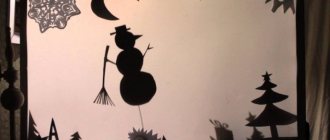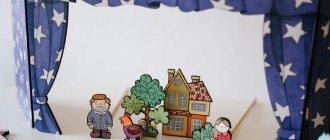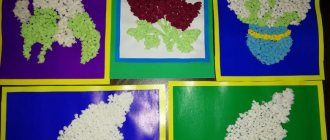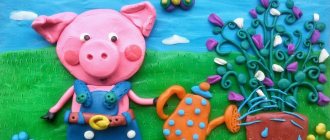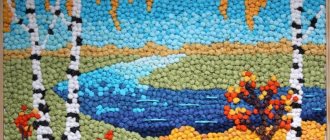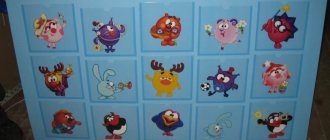Shadow theater is one of the oldest forms of theatrical art. The first mentions of it appeared before our era. There is a beautiful legend associated with the shadow theater:
The Chinese emperor's beloved wife fell ill and died. Plunging into grief and sadness, the emperor ceased to be interested in the affairs of the empire. For days on end he did not leave his personal chambers, remaining in the darkness behind heavy curtains. The husband of the deceased was inconsolable, and the time of decline and collapse came to the great empire - it crumbled like a house of cards.
But one day, behind a curtain illuminated by the sun, the emperor saw the silhouette of a courtier, so similar to the beautiful profile of his deceased wife. Since then, every evening the courtier performed a shadow performance for a single spectator. The imperial melancholy began to thin out, and along with its disappearance, the true ruler returned to the empire. The era of stagnation has passed, but it was during these times that a new genre of theatrical art was born.
Basic principle: how it works
The basis of such theater is “playing” with shadows. The performance is created by light sources. The figure or object is illuminated and a shadow appears on the screen. That is why creating such a theater with your own hands will not be difficult.
Black and white representations are not the only option. Scenes can be “painted” in different colors. You will need colored light bulbs or filters that are attached to the light source. For example, for an evening city scene - a dark blue filter, for a morning scene - shades of yellow.
Stage and scenery
If you use puppets in the performance, then you should decide on the stage on which the performance will take place. For example, it can be made from a large rectangular box: a large hole is cut out in it, which is then sealed with a white sheet of paper.
Also, shadow theater looks more impressive if you use decorations. They can be cut out of paper and attached along the edge of the screen.
At the same time, it is important that, on the one hand, the scenery is clearly visible, and on the other, there is enough space left for the characters in the play in the center of the screen.
Thus, shadow theater in kindergarten is not only an element of entertainment for children, but also an element of their own creativity, as well as a component of the child’s education and development system. In addition, activities of this kind stimulate the emotional sphere of children - emotions accompany both the process of preparing a performance, making characters and scenery, and the plot of the play itself. The curtain, of course, adds an additional effect to the performance.
Stages of creating a shadow theater
Making a shadow theater for children with your own hands combines two stages: preparing the stage and creating characters. The approximate time that needs to be spent is about 30-40 minutes. But if you start decorating and creating puppet characters, it will take a little more time.
For the theater to “work”, you will need:
- Choose a suitable light source.
- Make a screen out of a sheet, whatman paper or white paper.
- Take care of the frame (made of cardboard or an artistic stretcher).
- Correctly position the light source, screen and characters.
Shadow theater templates: Zayushkin's hut template
A fascinating shadow play about a bunny and his hut, suitable for preschool children. Simple lines and uncomplicated scenery are what the young viewer needs.
Selecting a lighting fixture and a suitable screen
When creating a shadow theater with your own hands, you need a light source: an ordinary flashlight, a table lamp or any other adjustable lamp. You can even use mobile phone lighting.
A translucent white plane is used as a screen. The size is not limited - it all depends on the light power. For the screen, materials that are at hand are suitable: tracing paper, a thin white sheet or a simple Whatman paper. And if this is not the case, you can fasten sheets of snow-white paper together.
To make the scene look more impressive, you will need a frame for the screen. It is made from an artistic stretcher or cardboard. For example, a do-it-yourself shadow theater for children is done this way: choose a suitable box and cut out the bottom.
Then take parchment paper, cut it into a rectangle and stick it to the bottom of the box. All that remains is to decorate the layout as you wish. You can also stretch fabric over a small frame.
Using additional funds
If the performance is aimed at children in the older group of kindergarten, it is possible that the finger shadow theater will captivate them less. Still, this activity is more suitable for kids. How to make shadow theater more vivid and memorable? In this case, it is possible to use additional funds. So, for example, if we are talking about a performance in an educational institution, and not about a family evening at home, it is better to use a real, professional screen.
The characters for the performance can be either ordinary dolls or silhouettes specially made from various materials. In this case, it is better to choose black material for cutting out characters. It is better to attach the cut out silhouettes to sticks. You can complicate the action by using more mobile forms. For example, these could be articulated dolls that move using special ropes.
Characters for the theater
Shadow theater varies depending on the characters. There is, for example, finger theater - shadows from hands are used. The fingers are folded to form the desired ones. This kind of theater is good for children - it develops hand motor skills. For such performances, a small “stage” is suitable.
The puppet theater looks bigger. This implies a performance with additional decorations and figures. Stencils can be used to create a shadow theater with your own hands for children. The size of the dolls is approximately 10 cm (height and size can be easily changed due to distance and approach).
The figures are created from cardboard, fixed on wooden skewers or also on cardboard. You can do it differently: cut out paper figures and stick them on cardboard. It is important to coat the material with glue, but not generously, so that the base does not deteriorate.
The dolls need to be dried under pressure, and then additionally coated with a layer of PVA glue on top. A semi-dry brush is required. It is advisable to paint cardboard dolls with black paint - they will be more noticeable.
Shadow theater templates: turnip fairy tale template
When acting out the shadow play of the fairy tale about the turnip, you can follow the plot and voice famous characters using the suggested templates.
If you want a more spectacular performance for children, you can come up with your own characters and change the scenes. To make heroes, you can use either black cardboard or regular cardboard, but painted with black paint. To improve the silhouette of the shadow, the blank can be decorated with feathers, openwork lace, and pompoms.
Decorations for different scenes:
Position of screen, light source and characters
The screen is placed between the audience and the lighting fixture. The light source is placed slightly to the side, not too close to the screen itself. Then the shadows will be clearer. Distance – about 25 cm.
The shadow changes depending on the distance between the figure and the light source. To make the wolf, for example, appear larger, you need to move the character further away. For the first productions, it is advisable to use a few characters - two or three are enough. With practice, you can create more complex representations.
Shadow theater templates: Chicken Ryaba template
A short story about a pockmarked hen will appeal to the youngest viewers. Using the proposed templates and suitable decorations, you can perform an interesting and unusual performance.
Complicated version
You can create a shadow theater for children using templates with your own hands in half an hour, but if you have more time, it’s worth thinking through additional details. For example, add decorations. They are created from cardboard and attached tightly to the screen using tape or paper clips. Then the decorations will not fall unexpectedly.
It’s easy to “revive” the figures - make them more mobile using soft wire. It is used to wrap arms, legs, wings and other parts.
It’s easy to “play up” an evening with a performance: decorate the curtain and draw bright tickets. And if several performances are planned, print out programs for spectators. And, of course, you need an intermission, during which you can treat the audience to delicious home-cooked food.
Shadow theater templates: Kolobok fairy tale template
For a theatrical production of Kolobok, you will need a template with the main characters. It needs to be printed, cut out silhouettes, and if possible, laminated.
Another version of the main characters:
Then a stick should be attached to each workpiece. It's best to use a skewer, but popsicle sticks, cocktail straws, and toothpicks will also work.
When the characters are ready, start decorating. Print out the house template, as well as some forest decorations. Change the scenery during the performance to create a real fairy tale picture for the kids.
Scene selection
The best place to start is with folk tales. They have a simple plot and not many characters. By the way, in China, where shadow theater comes from, up to a thousand figures could be used during one performance.
Before giving a performance, you need to understand the mystery of shadow theater. For example, in order for a doll to disappear unnoticed (or suddenly appear), you need to turn it with its edge towards the screen and remove it.
Before giving a performance, you need to learn the secrets of shadow theater. For example, in order for a doll or decoration to disappear unnoticed (or suddenly appear), you need to turn it edge-on towards the screen and move it.
So that the audience does not languish while waiting for the “actors,” the dolls must be arranged in order in advance. When creating a theater on sticks with your own hands using a template, it is worth adding additional effects - sound. You just need to choose the right music. And if you move the light source, you can depict bad weather, a storm or snowfall.
Shadow theater has not changed much since ancient times. The lighting setup and use of silhouettes are exactly the same. But now for home performances it is much easier to find and print the necessary stencils. And in the past, dolls were created by masters who worked on the figures down to the nuances.
Shadow theater as a means of developing children's creative abilities
Bibliographic description:
Rashchupkina, O. N. Shadow theater as a means of developing children’s creative abilities / O. N. Rashchupkina. — Text: immediate // Pedagogy today: problems and solutions: materials of the III International. scientific conf. (Kazan, March 2021). — Kazan: Young scientist, 2018. — pp. 119-122. — URL: https://moluch.ru/conf/ped/archive/276/13933/ (access date: 11/21/2021).
Theatrical activities in kindergarten are a magical world of fairy tales. By playing in the theater, a child reveals his creative potential. It is theatrical activity that makes it possible to develop a child’s creative abilities to a greater extent. Different types of theater are used in kindergartens:
tabletop theater;
bench;
riding;
wrist;
floor;
living puppet theater
But shadow theater is very rarely used, moreover, there is very little literature in this direction.
Starting work on this topic, I studied the literature, tasks, means and methods of work, as well as the history of the shadow theater.
This type of theatrical activity is very relevant. Taking part in performances and their preparation, the child’s creative abilities develop, and also helps those children who have difficulties in communication, develops fine motor skills of the fingers. Children love to write; here they are puppeteers, which gives them an excellent opportunity to prove themselves as storytellers. Moreover, shadow theater is a good prevention of fear of the dark in children.
A little history...
The history of the emergence of this type of art in different countries is different, here are the most interesting:
In China, for example, it is more than 2000 years old; moreover, this type of theater is the ancestor of drama in China. The first records of such theatrical performances date back to 1000 AD. e., although researchers are sure that they existed much earlier. Most scholars claim that the art of shadow theater has its roots in China. According to ancient legend, Emperor Wudi loved one concubine very much, and took her death too hard. Nothing made the Emperor happy, he was so devastated that he even abandoned all important matters. The courtiers tried their best to bring him back to life, but nothing helped, and then one of the court artists created a paper doll that looked like a concubine. When night fell, the Emperor was invited to watch. Having illuminated the silk screen, the courtier depicted her movements and imitated her voice. The emperor was so inspired that he returned to life and his duties.
By the second millennium, shadow theater was very common in China and India. With the troops of Genghis Khan it also spread to other regions of Asia. It reached its highest form in Turkey in the 16th century and was popular in the Ottoman Empire. In 1767, the shadow theater technique was brought home from China by the French missionary Jules Alod. In 1776 she became famous in Great Britain. The German poet Goethe showed interest in this art, and in 1774 he himself staged a performance of it. The Tangshan shadow theater remains one of the most famous and influential in China in the 21st century. In Chengdu there is a shadow theater museum (Chinese: 成都中国皮影博物馆).
Today, delicately crafted leather puppets are prized among collectors, and the shadow theater itself, in its classical form, is in danger of disappearing.
In the mid-2000s, a new movement of shadow theater emerged, in which, instead of puppets, dancers, using their flexibility and plasticity, create performances using, first of all, their bodies. By the end of the decade, the movement gained great popularity and in many countries around the world their own shadow theaters began to emerge. The most popular of these new shadow theaters can be considered the Pilobolus shadow theater. And among the famous ones you can also name Attraction, El Gamma Penumbra, Delight, Fireflies, Verba, Three Wings, Shadow Theater Show from Moscow, SHADOW LAB, from the SHIK-BALET project.
Theater activity is one of the forms of working with children in kindergarten that reveals and develops the child’s creative abilities. Such activities contribute to a more productive assimilation of the targets defined by the program.
According to the principles of the federal state standard, the implementation of the Program must be carried out in forms specific to children, primarily “... in the form of play, cognitive and research activities, in the form of creative activity that ensures the artistic and aesthetic development of the child...”
Preschoolers love to watch plays. It is understandable and accessible to them, and shadow theater also contains elements of animation. Children see familiar and favorite characters on the screen: a bear, a cat, a bunny, a horse, modern cartoon characters: Smeshariki, Luntik, Barboskins, Ninjago, and many others. Children are delighted that these characters move, talk, and address the audience. It is important to consider theater not only as an entertainment event, but also to show through performances examples of friendship, honesty, hard work and kindness. It is at this age that children develop their character, interests, and attitude towards the world around them.
How to organize a shadow theater in a kindergarten group? The main thing is to have a desire! Undoubtedly, and the role of parents here is very important.
One of the main objectives of the Federal State Educational Standard for Preschool Education is to provide psychological and pedagogical support for the family and increase the competence of parents (legal representatives) in matters of development and education, protection and promotion of children's health. The main idea of interaction between parents and a preschool institution is that parents are responsible for raising children, and all other social institutions are called upon to help, support, guide, and complement their educational activities. That is why it is necessary to involve parents in joint ideas and projects. From my work experience, parents are very happy to meet with the teacher. Parents took a direct part in the creation of our shadow theater.
It’s easy to prepare everything you need for the display. The screen can be made from a large cardboard box, cut out the screen, glue tracing paper or a white sheet of the desired size. I bought the lamp on a clothespin, it is very practical. The main thing is that the light is located between the actor and the screen; for this, the lamp is attached to the top and directed towards the screen.
You can draw characters and scenery yourself. Although there are other options, for example, ready-made templates can be purchased online.
The selection of pictures is very important; it is desirable that all the characters of one fairy tale be made in the same style. When sets of pictures are compiled for each literary work, this helps to maintain the scale of the pictures and their stylistic decisions. It would not be logical if, for example, in the fairy tale Masha and the Bear, Masha suddenly turns out to be taller than the bear, or in the fairy tale “Bubble, Straw and Lapot” suddenly Straw turns out to be wider than Laptya.
The conventions of the theater are close to preschoolers; they are accustomed to it in their games. This is why children are so positively involved in the magic of what is happening on the screen: they answer the characters’ questions and help them, warning them of danger. The unusualness of the spectacle captivates them and transports them to the world of a fairy tale. Theatrical activities bring children joy and indescribable delight.
We live in the Arkhangelsk region, here the winter days are very short, it is mostly dark during the daytime, and this is the most favorable environment for shadow theater. At the same time, this is a wonderful prevention of fear of the dark in children. Why be afraid of the dark when you can play so interesting and fun. We started simple dialogues with the children in a finger shadow theater. This form of work allows, among other things, to develop fine motor skills of the fingers; here, poems, fables and short fairy tales known to the child were taken as a script.
The role of the teacher in organizing and conducting the performance is great. It is important to organize joint activities and take an individual approach to each child. Set clear goals for children and give them the initiative. Pay attention to the difficulties of each child, if any.
In her work she used not only folk tales, but also original ones. So, for example, in the book “Puppet Theater” by T. N. Karamanenko and Yu. G. Karamanenko, scenarios of fairy tales by various authors are presented. Fairy tales are not complicated, interesting, funny and instructive. They showed fairy tales to the children, not only in the group, but also invited parents and children from neighboring groups. We took part in a city competition, where we took first place. Feedback from those present speaks for itself about the importance of this type of activity. For example, a review from the parent of one of the students, Marina Ruzavina:
On January 18, 2021, I was in the theater, which was created thanks to the efforts of the teacher of our group No. 7, Oksana Nikolaevna Rashchupkina. The performance was based on the Ukrainian folk tale “Spikelet”. The actors are the guys from the group, they all took the task assigned to them responsibly, rehearsed a lot and learned the words.
The shadow theater performance went well; some of the actors forgot the words of their role due to their emotions, but were still able to cope with the excitement.
The audience watched the performance with interest, laughed and clapped. All the children not participating in the play had to promise that in the next production they would also become actors.
Organizing a shadow theater performance was an excellent idea of the teachers, thanks to which the children got acquainted with this type of theater and saw its “behind the scenes” side. The participation of children in such productions forces them to show their imagination and develop speech, creativity, and artistry. Children prepare for a common action together, rehearse, and strive to perform well in front of their friends.
The children were able to show the different characters of the fairy tale heroes - the positive hero of the cockerel, hardworking and responsible, and the desire of the mice to imitate him and fight their shortcomings. I liked the performance, I will gladly come to watch the next production, and I wish the teacher good luck in this rather difficult matter.
Feedback from parents is always positive, because it’s nice to look at your child, so the opinion of teachers is also important: teacher of additional education of the first qualification category MBOUDO Youth Center P. S. Ilyushenkova:
Theatrical entertainment “Bad Ponytail” is intended for preschoolers aged 6–7 years. The main goal of this entertainment is to create conditions for the emotional development of children in the process of theatrical activities. The goal was achieved through the implementation of the following tasks:
Educational: Promote the use of both verbal (tempo, voice strength, intonation expressiveness) and non-verbal (gestures, facial expressions, posture) means of expression. Induce in children a state of creative search and inspiration. Stimulate the development of attention, memory, thinking, imagination.
Developmental: To develop children’s ideas about the moral qualities of a person, confidence in the victory of a good beginning. Develop plasticity, motor skills, sense of rhythm, musical abilities.
Speech: Introduce children to new words: curtain, scenery, poster, applause, indignation.
Educational: Cultivate a friendly, emotionally positive attitude towards each other.
When visiting the entertainment, I made the following conclusions: the techniques and methods used during the entertainment were fully consistent with the age-related psychological and physiological characteristics of children 6–7 years of age. During the lesson there was a change in types of activities sufficient for the teacher and children to successfully complete tasks without visible fatigue or boredom.
The teacher and the children carried out a lot of preparatory work, which undoubtedly had a huge impact on the development of the emotional intelligence of the students. This entertainment develops children's creative abilities, promotes activation of imagination, development of logical thinking, offering children a situational and active approach to solving various types of problems.
I would especially like to note the activity and interest of all the guys during the entertainment.
In my opinion, carrying out such work increases the self-esteem of preschool children, teaches them the ability to listen and hear, helps the students’ self-presentation, unites the children’s team, and teaches them to treat each other with respect and tolerance. The proposed material complies with the Federal State Educational Standards for the organization and content of the educational process in preschool institutions. The proposed games and creative tasks allow children to demonstrate acting skills, overcome the difficulties of interpersonal interaction, contribute to the development of speech skills, and increase the level of general culture. This form of leisure time is most justified for children of senior preschool age, since it is one of the forms of preparation for school and can significantly increase the interest of preschoolers in learning. I believe that it is useful to develop this form of work further, perhaps by involving the pupils’ parents in various preparatory work.
Of course, in a group setting, you shouldn’t demand to do a big, complex performance that only professionals can do - this is both impossible and makes no sense. Let it be better to have a small fairy tale, a short dialogue between the characters acted out by children, what is important here is the interest of children, their imagination and creative solutions. It is necessary to conduct shadow theater games systematically.
Of all the types of puppet theater in kindergartens, shadow theater is the least popular. And it seems to me that he is undeservedly deprived of the attention of teachers. The magic of shadow theater creates a warm, homely atmosphere where even the most shy and timid child will show a desire to be an actor, because he is not visible behind the screen, and he slowly begins to liberate himself.
Literature:
- https://ru.wikipedia.org/wiki/Shadow_Theater
- https://kladraz.ru/blogs/elena-sergevna-gribova/-sovremenyi-tenevoi-teatr-v-dou.html
- https://www.maam.ru/detskijsad/vzaimodeistvie-dou-i-semi-v-ramkah-vedenija-fgos-do.html
- https://diplomba.ru/work/103949
- https://infourok.ru/teatr-teney-kak-sredstvo-razvitie-tvorcheskih-sposobnostey-detey-1763062.html
Key terms
(automatically generated)
: child, shadow theater, shadow theater, China, theatrical activity, type of theater, kindergarten, child’s creativity, form of work, theatrical activity.
